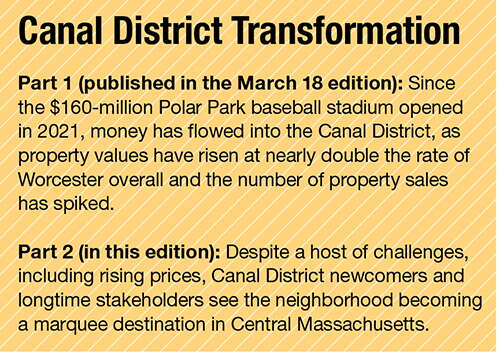
Canal District Transformation, part 2: Creating the next chapter
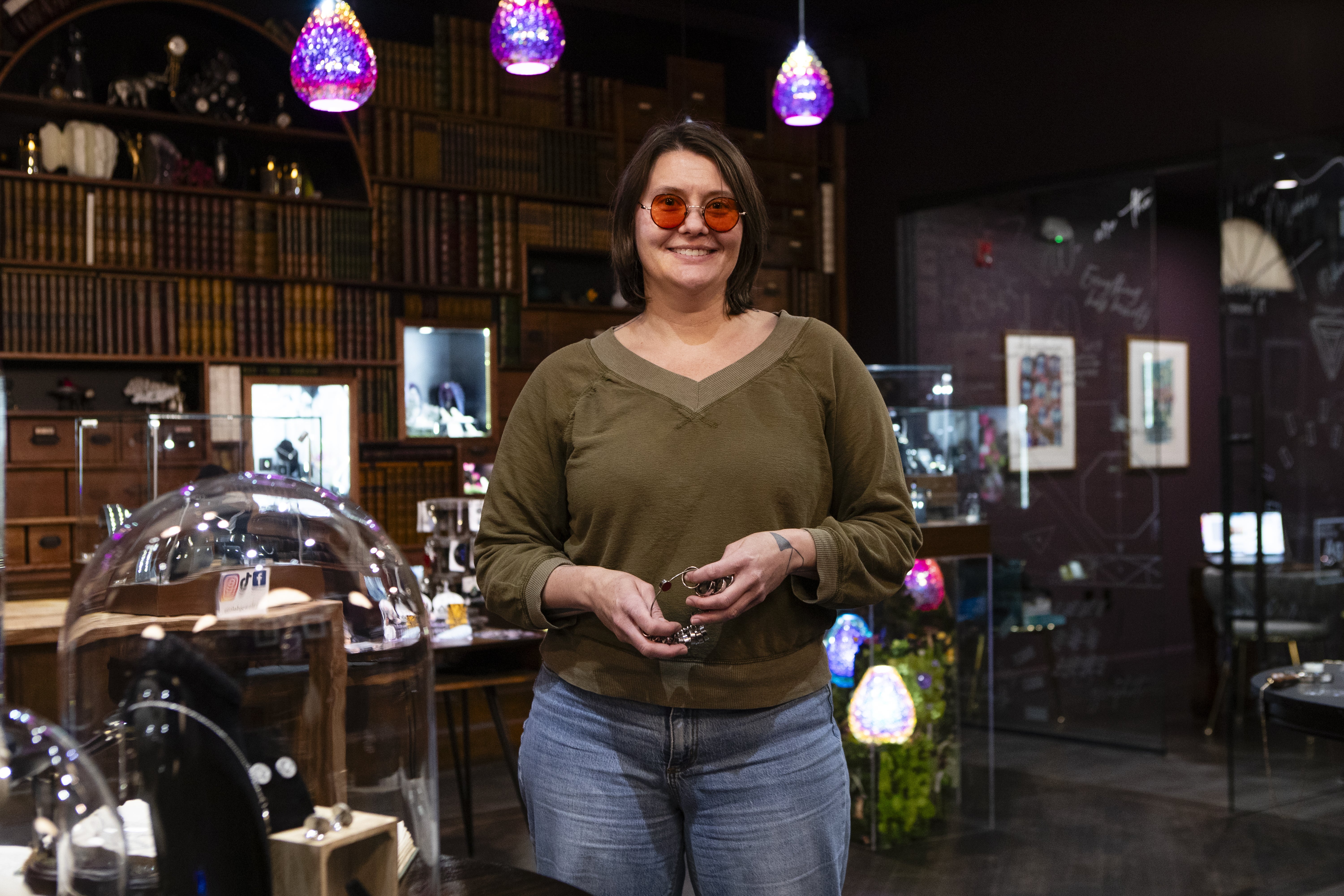 Photo | Matt Wright
Ilah Cibis opened iLah Jewelry in September, hoping to benefit from the rapid growth of the Canal District and Worcester's population of young unmarried people, who should be on the hunt for items like custom engagement rings.
Photo | Matt Wright
Ilah Cibis opened iLah Jewelry in September, hoping to benefit from the rapid growth of the Canal District and Worcester's population of young unmarried people, who should be on the hunt for items like custom engagement rings.
More Information
At the northern edge of the Canal District neighborhood in Worcester sits iLAH Jewelry. After operating a design studio in Sudbury for 15 years, Owner Ilah Cibis opened her immersive and quirky store in an industrial building on Franklin Street in September, seeking a younger clientele who might be shopping for engagement rings or trendy handmade items.
“It was very calculated,” Cibis said of her decision to move to the Canal District. “Part of the calculation was finding a space where [the business] would make sense in the neighborhood, maybe not immediately to some people, but at some point.”
The Canal District has seen much transformation since 2010, evolving from a rundown and overlooked section of the city to a trendy neighborhood complete with quirky businesses operated by an eclectic mix of small-business entrepreneurs. Now, a flood of new residents, the construction of the Polar Park baseball stadium, and a wave of development have shone the next spotlight on the neighborhood, driving up real estate prices and permanently altering the district’s landscape in the process. Developers and business owners expect that growth to continue, saying new businesses and even more residents will soon make the area home, creating the next chapter in the long history of the Canal District.
“The press tends to focus on the downs, but what they don’t think about are all the positives that have happened here,” Amy Chase, who opened in 2012 the Canal District staple Crompton Collective, said in an email to WBJ. “Having worked in The Canal District for 20 years, I have witnessed numerous iterations of this neighborhood. The current version is undeniably the most vibrant, welcoming, and successful. I believe that we will further progress towards becoming a truly walkable and valuable destination for both visitors and residents.”

New interest, new residents
Commercial sales volumes and tax assessment values have been on the rise in the neighborhood, according to a WBJ analysis of 204 properties in the 92.25-acre district studied for part one of this two-story Canal District Transportation series. The tax assessment value of Canal District properties – not counting the Polar Park parcel itself – rose from a combined $87.41 million in 2021 to $159.95 million in 2024, an 83% increase and more than double the citywide increase.
The increase in tax assessment value has been mirrored by an increase in property sales. In the 5.5 years since the 2018 announcement of the Pawtucket Red Sox’s planned move into a Canal District baseball stadium, the neighborhood had 86 real estate sales, compared to 50 sales in the 5.5 years before the announcement, according to City property records.
The sales prices of those properties is up, too; the total property sales volume from August 2018 to February 2024 was $24.3 million, an increase of 183% compared to the 5.5 years before the Worcester Red Sox announcement, according to data from real estate information provider CoStar, outpacing the 55% increase citywide and the 42% increase in Massachusetts.
But the changing nature of the Canal District, even before the completion of Polar Park, isn’t just captured in the dollars and cents of property sales and assessment valuations, as data from the U.S. Census Bureau provides insight on how the neighborhood changed from 2010 to 2020, before the stadium opened in 2021.
Figures from Census Tract 7325, an area encompassing about 192 acres of the Green Island and Canal District neighborhoods, shows the area’s population increased from 1,776 people in 2010 to 2,490 in 2020, a 40.2% increase nearly triple the growth rate of 14% seen across Worcester during the same time period.
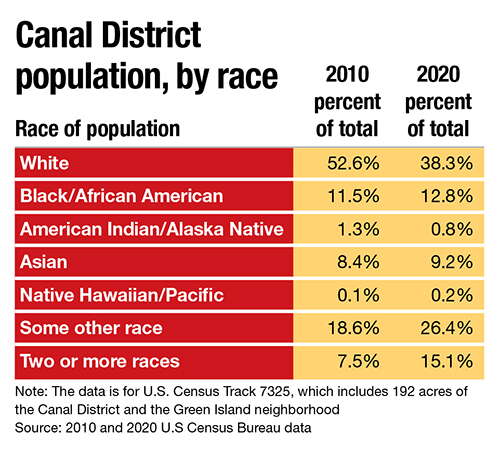
Newly arriving residents into this region came from a wide variety of racial demographics, according to Census data. White individuals made up 52.6% of residents in 2010, but 38.3% of its population in 2020, with the largest gains seen in people who identify as a race not listed by the Census or as two or more races.
This influx in new residents was helped by the creation of new housing stock. While Polar Park-related housing developments were still mostly in the pre-construction phase, the amount of housing units in the area’s census tract increased from 821 units in 2010 to 1,121 in 2020, a 36.5% increase, larger than the citywide increase of 12.9% seen during that time period.
More of the housing stock was being utilized by 2020 as well, with an 86.6% occupancy rate, compared to an 83.1% rate seen in 2010. Both of these rates are under the citywide rates of 91.9% and 93.9% seen in 2010 and 2020, respectively.
New housing stock
While the lack of available financing and rising construction and labor costs have caused some Canal District developers to scale back plans for new housing, 800 new apartment units are expected to come online in the next year or so, said Mike Jacobs, principal at Worcester-based commercial real estate agency NAI Glickman Kovago & Jacobs.
Plenty of apartments are on the way, but who is able to afford them is another matter. While the development at the former Table Talk Pies manufacturing site includes 53 affordable units, the Revington and The Cove developments don’t include any, as they were approved before the implementation of Worcester’s inclusionary zoning rules, which requires a certain amount of affordable units in every newly constructed housing complex.
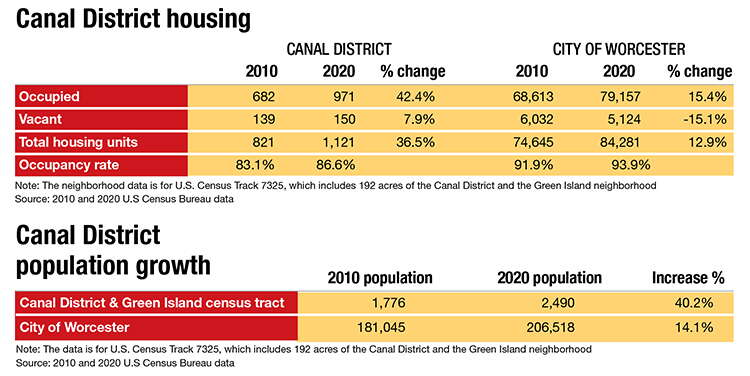
Available listings for new apartments show developers are clearly banking on the idea that new residents in the Canal District will be wealthier than the average Worcester renter. Monthly rents for studio apartments at the Revington are listed at $1,975, while one-bedroom units are $2,256 and two-bedroom units are $3,108.
The average rent throughout Worcester is $1,366 for studios, $1,631 for one-bedroom units, and $1,883 for two-bedroom units, according to data provided by rental unit listing site Apartments.com.
Future Canal District businesses
With higher commercial property values, rents for small businesses leasing in the district are expected to rise. Understanding the fact the neighborhood has gone through a lot of change since 2018, Jacobs said rates six years were generally $13-$26 per square foot, which he expects to be the low-water mark moving forward.
While these prices may have offered a fairly low barrier of entry for small shops and locally owned restaurants, higher rents give businesses a smaller runway for learning how to operate on the fly, increasing the likelihood more established businesses with deeper pockets will begin to call the Canal District home.
Businesses looking for a commercial lease in one of the new mixed unit developments are looking at rental rates of $30-$40 per square foot, said Jacobs.
Other retail and service-based businesses in Central Massachusetts paying rents in the $30-$40 range include hair salons, spas, tax firms, and music studios, according to CoStar data. Many of these businesses are locally owned, but also include national chains, such as Minnesota-based salon chain Supercuts and Virginia-based Liberty Tax Services.
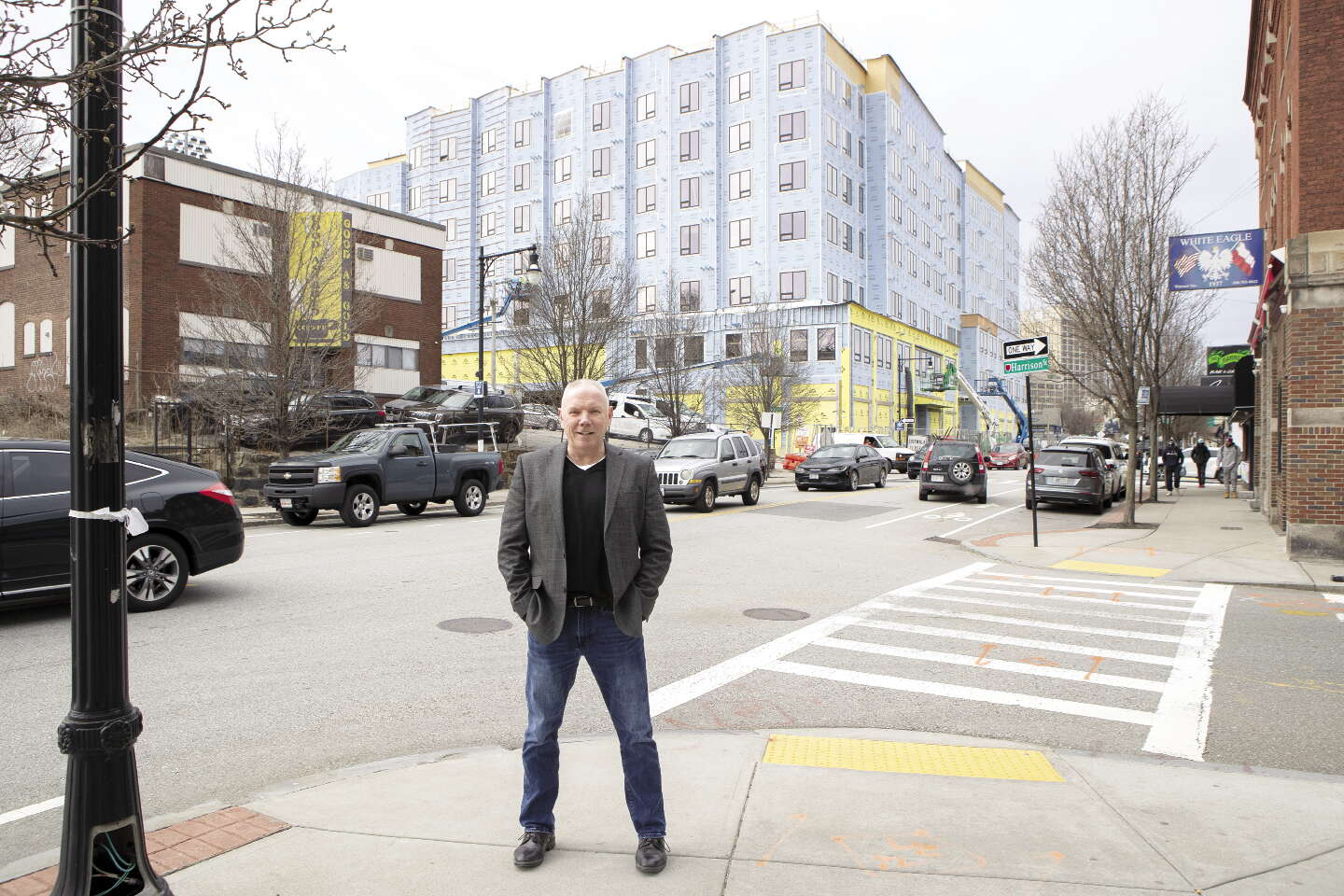
Jacobs sees new restaurants and breweries joining existing businesses of these types in the district. Other businesses eyeing potential locations in new Canal District spaces include dance studios, bakeries, package stores, banks, and cell phone stores.
“The end result will be a mix of these types of businesses,” he said.
One hurdle to creating a truly self-sustaining, walkable neighborhood is the lack of a pharmacy or grocery store. While the Canal District has a number of smaller specialty food markets, one-stop shopping for everyday essentials generally requires a car or bus ride.
Multiple grocers are eyeing the area for potential locations, Jacobs said.
Of course, a large supermarket or pharmacy usually comes along with a large parking lot, conflicting with the goal of creating a high-density neighborhood.
“Part of the challenge we have down in the Canal District is space. If we were to convince [a small grocer] to open in the district, we actually have the necessary space and the parking ratios to provide them,” Jacobs said.
Despite the Canal District’s reputation for small, owner-operator businesses, one corporate brand with a reputation for its ability to build supermarkets in areas with little parking keeps coming up among the neighborhood’s players: Trader Joe’s.
“My perfect market would be about 5,000 square feet. A Trader Joe’s is a full-service market within that range,” said Dino Lorusso, the developer behind Crompton Place. “I don’t think we want a 20,000- or 25,000-square-foot market.”
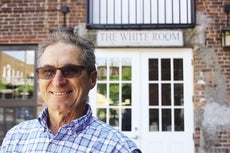
Famous for its small parking lots, Trader Joe’s has opened stores with no dedicated parking at all, including one in Boston’s Back Bay neighborhood and another one in its trendy Seaport District. A Trader Joe’s spokesperson told WBJ said the company is always considering expansion but declined to offer any specifics about potential Worcester or Canal District locations.
Taxes and economics
With commercial rental rates and tax assessment values climbing, businesses are dealing with climbing property tax payments, a potential threat to further growth, said said Jimmy Kalogeropoulos, owner of RE/MAX Partners Advance Group on Harding Street.
“The commercial tax rate is going to end up crippling economic development in the city of Worcester,” said Kalogeropoulos, who noted the yearly tax payments on a 1,200-square-foot commercial building he bought are $8,000 per year.
Taxes aren’t the only economic factor potentially weighing down growth. Real estate prices in the area aren’t always in tune with reality, said Ed Murphy, president development firm Baystate Investment Fund, which is headquartered on the Canal District’s Kelley Square.
“The real estate values in the neighborhood have trickled back some in the last year or two. At the same time, the cost to own buildings has increased significantly. Property insurance is way up, taxes are up, and utilities are up,” Murphy said in an email to WBJ.
Despite the slight cooling, the real estate market in the Canal District remains hot. Perhaps too hot, as Murphy said some transactions he’s seen in the area aren’t based in reality.
“What some buildings were being sold for simply did not make sense,” Murphy said. “One deal in particular I passed on sold for double the price I passed on buying it for three months prior. Tenants are only able to pay so much in rent, and if the rent is too high, the tenants will fail.”
Certain property owners who didn’t sell in the immediate wake of the 2018 Polar Park announcement in hopes values would continue to increase may now be regretting that decision.
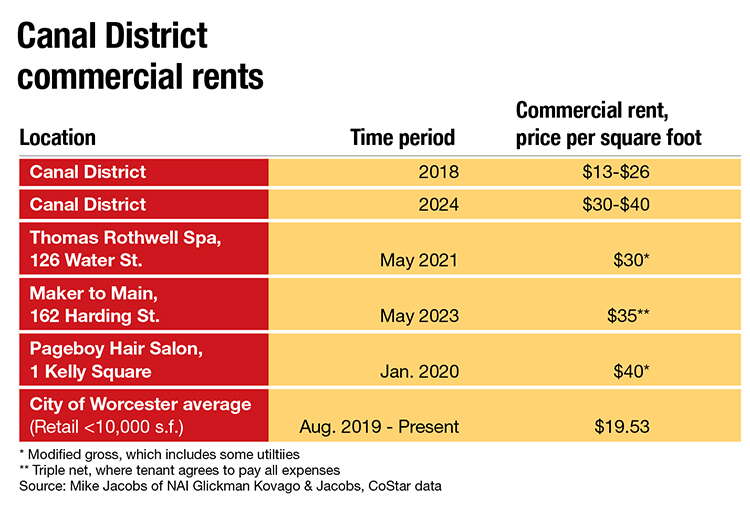
“When the WooSox announced they were coming, I would meet [property owners], and you could see all of the dollar signs in their eyes,” said Jacobs. “People have definitely sold at a much more positive value than was previously, but some of the people have not gotten what they wanted. I’m not sure that’s ever going to materialize because of the overall direction of the commercial market.”
Yet, higher real estate prices don’t necessarily have to translate to higher costs for businesses if property owners are willing to take a more long-term and cooperative view.
Chase, owner of Crompton Collective, said she’s witnessed both developers who are solely focused on profit and those who want to help tenants succeed.
“In any area, there will be developers who are fair and willing to collaborate with tenants to enhance the neighborhood, as well as developers solely focused on maximizing profits, leading to higher prices,” she said. “This dynamic is something I have observed in every location where I have stores. Fortunately, there are many landlords in this area who are committed to supporting and nurturing small businesses to thrive.”
Canal District property owners are valuing quality tenants over making a quick buck on a business destined for failure, Jacobs said.
“Almost all of the landlords are looking for strong tenants,” he said. “I don’t think they are holding out for every last dollar.”
Neighborhood business closures
As the Canal District has transformed since 2018, a number of high-profile businesses have closed, although they all cited multiple factors and weren’t tied to one overarching reason specific to the neighborhood. The Dive Bar, Smokestack Urban BBQ, Worcester Ware’s then-second location inside the Worcester Public Market, Maddi's Cookery and TapHouse, and The District Wood Fired Kitchen are just some of the smaller businesses closed in the neighborhood since 2018.
Perhaps the most recent high-profile Canal District closure was the Maker to Main curated grocery store in January 2024. Despite the neighborhood’s need for a grocer, Owner Lynn Cheney said Maker to Main was always facing an uphill battle, after buildout of the space took three times longer and was much more expensive than initially anticipated.
Cheney said it’s possible the city government could do more to help business owners navigate the labyrinth of steps needed to open, but she didn’t blame elected officials or the slower-than-anticipated progress of the more affluent apartment construction, even admitting the store may have been ahead of its time.

Instead, Cheney pointed to the small margins facing smaller grocers and consumers being unable to financially support locally-owned businesses.
This concern was echoed by a number of business owners inside and outside of the Canal District – including Ilah Cibis of iLah Jewelry, Jessica Walsh of Worcester Wares, and Dani Babineau of Redemption Rock Brewing – during a November small business summit held in Worcester.
“It’s not the City’s fault. It’s not Polar Park’s fault. It is our responsibility as residents to patronize places so they continue to thrive. You can’t just use the hashtag #shoplocal but then not actually do that on a weekly basis,” Cheney said.
Parking and poverty
If Worcester is to be a true city, attitudes toward cars and parking need to change, said Cibis from iLAH Jewelry, as the supposed lack of parking is cited as a reason Canal District businesses fail.
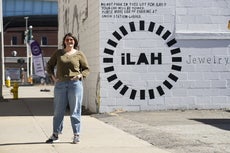
“There is not a parking problem,” she said. “It’s a perception thing. There’s plenty of people in the city that would argue with me until they’re blue in the face, but from my perspective, there’s street parking, municipal lots, and the Union Station garage. For those of us who are able-bodied, there's lots of parking here.”
These views on parking are echoed by multiple Canal District business owners in the area. The Worcester Red Sox have a page on their website dedicated to connecting patrons with potential parking spots. An infographic on the page notes more than 7,000 parking spots available within a 10-minute walk of the ballpark.
“I don’t believe the Canal District has a parking issue,” said Jefferson Mararian, former Canal District Alliance president and owner of 107 TAP, a bar on Water Street. “It’s just a lack of knowledge of where it is and the fact that some people have to walk.”
The lack of a permanent center providing comprehensive services for those struggling with homelessness and addiction represents another problem the Canal District must overcome. The business-related problems this causes pale in comparison to the struggles faced by homeless residents, but property owners and patrons often have to cope with people sheltering in doorways, drug use, and using alleyways as impromptu bathrooms.
“There’s not one shelter with wraparound services,” said Kalogeropoulos of RE/MAX Partners Advance Group. “[The City] can’t scrape together a couple million dollars to build a facility somewhere?”

For Ulysses Youngblood, president of Major Bloom, a cannabis dispensary operating on Millbury Street since 2021, the problem isn’t so much with unhoused residents as it is with people struggling with alcohol and opioid addiction issues. Youngblood said people have died from drug overdoses in the immediate vicinity of the store.
“Unfortunately, a lot of the people I’ve met are no longer with us,” he said.
People with substance issues loitering in the Canal District has a negative impact on Major Bloom, but Youngblood called for compassionate solutions.
“We’re all human, and you get to know these people,” he said.
The growth goes on
Despite the hurdles to transforming the Canal District into the vibrant mixed-use neighborhood envisioned by its business owners, developers, and residents, many are confident that the future of the area remains bright.
“There will be a second wave of development, and it’s hard to see anything bad about it,” said Allen Fletcher, founder and president of the Worcester Public Market and one of the neighborhood’s older champions. “Increased density, more people living here, that’s what we all want.”
The magic of the Canal District will continue, said Lorusso from Crompton Place.
“If I was starting a business today, the only place I would think about starting it is in the Canal District,” he said. “You can’t get a better location, because it’s growing.”
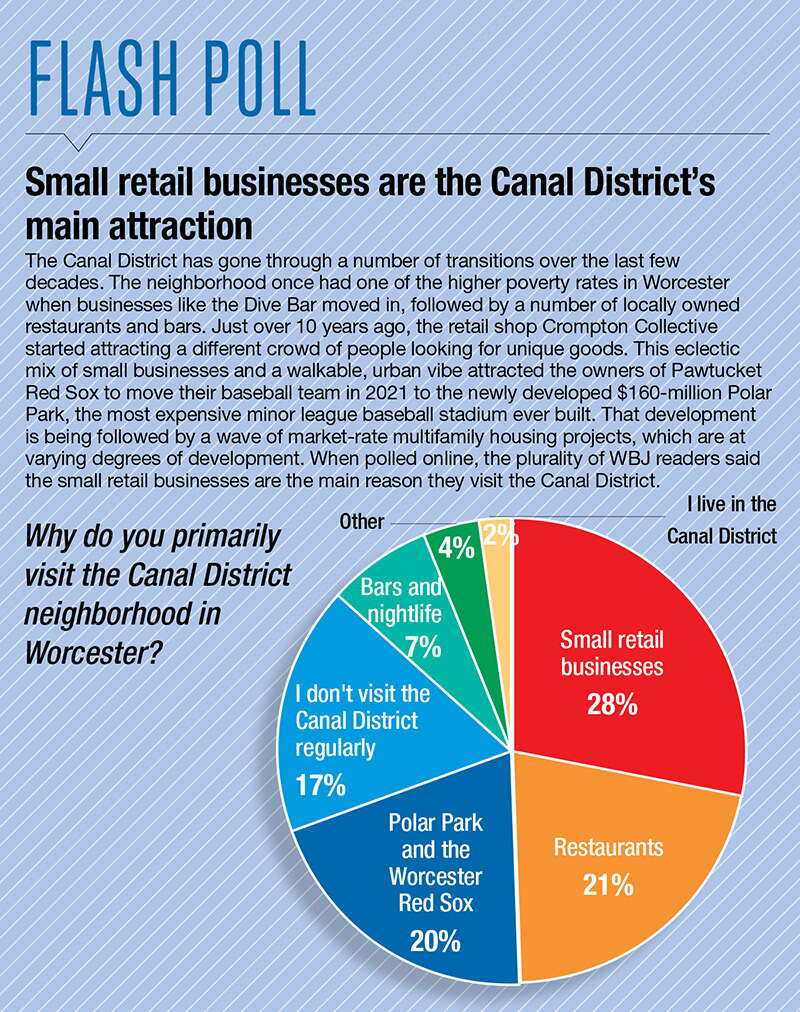






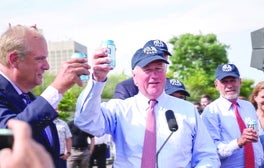






0 Comments